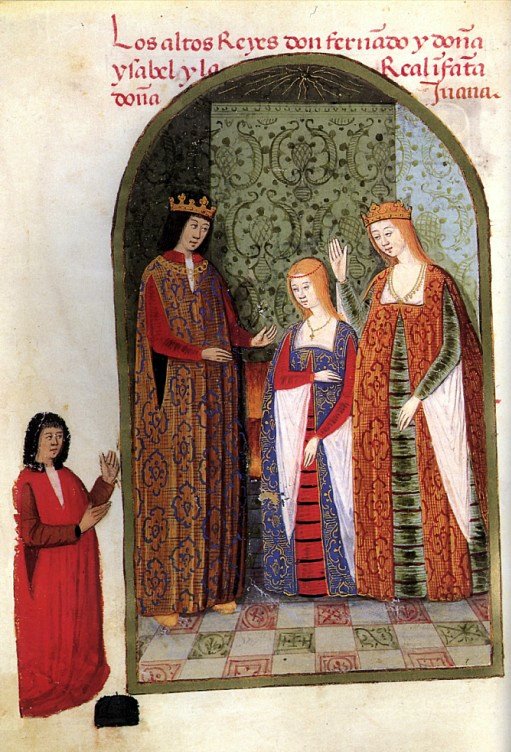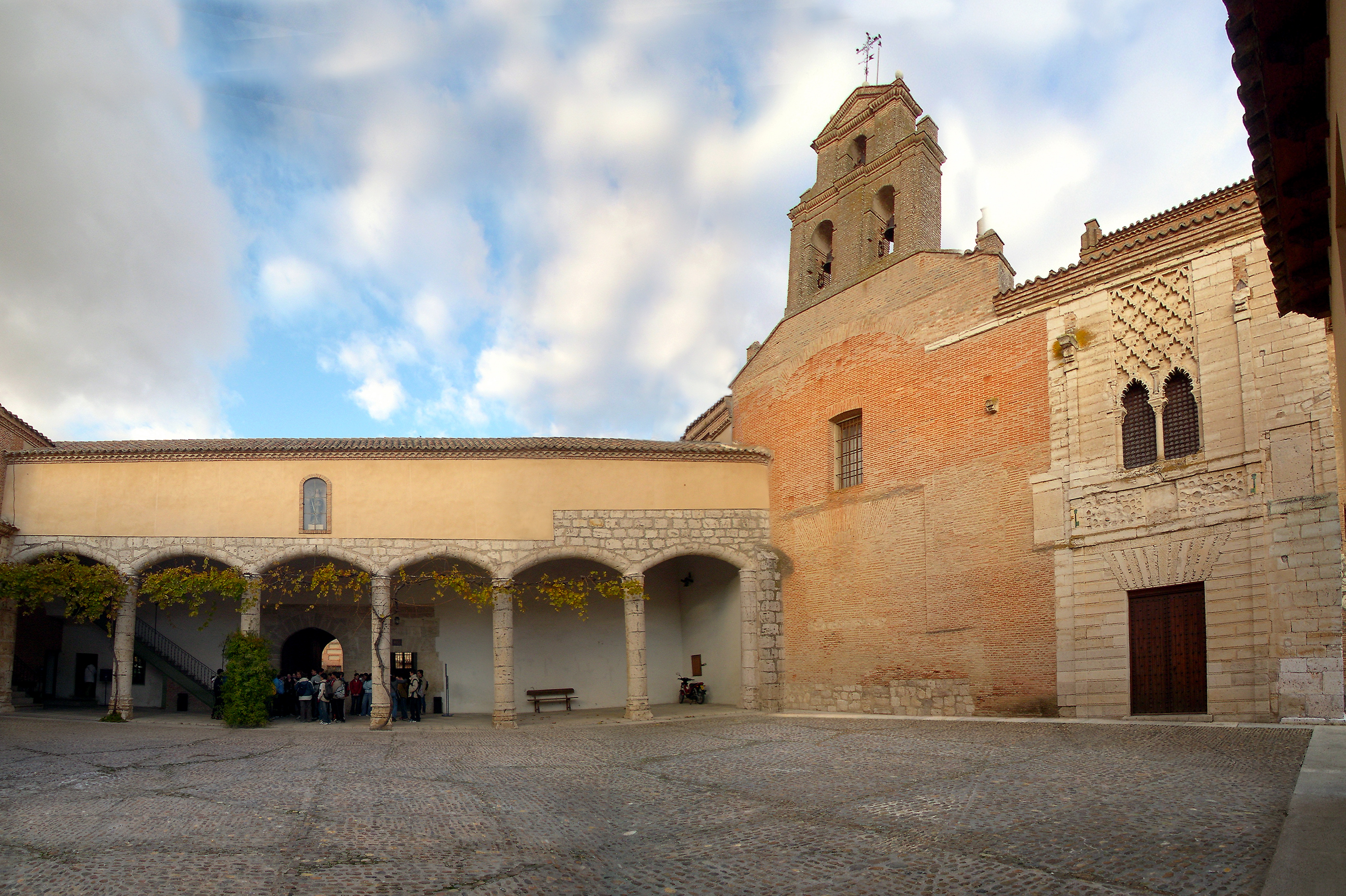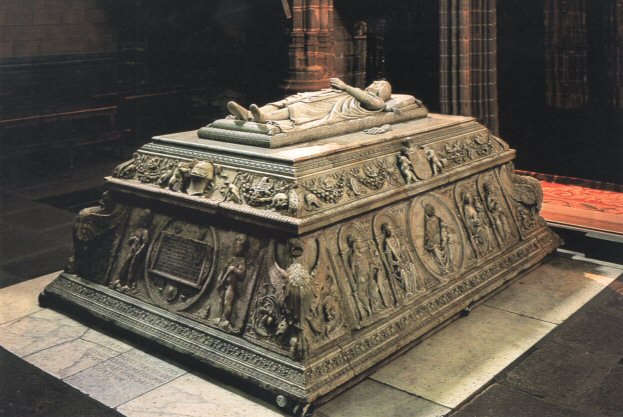|
Juana La Loca
Joanna (6 November 1479 – 12 April 1555), historically known as Joanna the Mad ( es, link=no, Juana la Loca), was the nominal Queen of Castile from 1504 and Queen of Aragon from 1516 to her death in 1555. She was married by arrangement to Philip the Handsome, Archduke of Austria, of the House of Habsburg, on 20 October 1496.Bethany Aram, ''Juana the Mad: Sovereignty and Dynasty in Renaissance Europe'' (Baltimore, Johns Hopkins UP, 2005), p. 37 Following the deaths of her brother, John, Prince of Asturias, in 1497, her elder sister Isabella in 1498, and her nephew Miguel in 1500, Joanna became the heir presumptive to the crowns of Castile and Aragon. When her mother, Queen Isabella I of Castile, died in 1504, Joanna became Queen of Castile. Her father, King Ferdinand II of Aragon, proclaimed himself Governor and Administrator of Castile.Bergenroth, G A, Introduction. Letters, Despatches, and State Papers to the Negotiations between England and Spain. Suppl. to vols 1 and 2 ... [...More Info...] [...Related Items...] OR: [Wikipedia] [Google] [Baidu] |
Master Of Affligem
The Master of Affligem or Master of the Joseph Sequence (working c. 1470–1500) was an accomplished painter of the South Netherlandish school, apparently working in Brussels, whose name is not known, but whose hand can be detected in a number of surviving paintings on panel. The pseudonym ''Master of the Joseph Sequence'' was given him as a name of convenience in 1923 by Walter Friedländer, who identified a series of tondi illustrating the Legend of St Joseph, which had become scattered among several museums, as all coming from the same painter. Subsequently Friedländer attributed to the same workshop eight further panels with scenes from two other sequences, the Life of Christ and the Life of the Virgin (c. 1493–1508; Brussels, Musée d'Art Ancien) These came from the abbey of Affligem in Brabant, providing the alternate name for the artist. The portraits of Philip the Handsome and Joanna the Mad on the wings of the ''Last Judgement'' triptych from Zierikzee (c. 1500, Roy ... [...More Info...] [...Related Items...] OR: [Wikipedia] [Google] [Baidu] |
Roman Catholicism
The Catholic Church, also known as the Roman Catholic Church, is the List of Christian denominations by number of members, largest Christian church, with 1.3 billion baptized Catholics Catholic Church by country, worldwide . It is among the world's oldest and largest international institutions, and has played a prominent role in the history and development of Western civilization.Gerald O'Collins, O'Collins, p. v (preface). The church consists of 24 Catholic particular churches and liturgical rites#Churches, ''sui iuris'' churches, including the Latin Church and 23 Eastern Catholic Churches, which comprise almost 3,500 dioceses and Eparchy, eparchies located List of Catholic dioceses (structured view), around the world. The pope, who is the bishop of Rome, is the Papal supremacy, chief pastor of the church. The bishopric of Rome, known as the Holy See, is the central governing authority of the church. The administrative body of the Holy See, the Roman Curia, has its pr ... [...More Info...] [...Related Items...] OR: [Wikipedia] [Google] [Baidu] |
Holy Roman Empire
The Holy Roman Empire was a Polity, political entity in Western Europe, Western, Central Europe, Central, and Southern Europe that developed during the Early Middle Ages and continued until its Dissolution of the Holy Roman Empire, dissolution in 1806 during the Napoleonic Wars. From the accession of Otto I in 962 until the twelfth century, the Empire was the most powerful monarchy in Europe. Andrew Holt characterizes it as "perhaps the most powerful European state of the Middle Ages". The functioning of government depended on the harmonic cooperation (dubbed ''consensual rulership'' by Bernd Schneidmüller) between monarch and vassals but this harmony was disturbed during the Salian Dynasty, Salian period. The empire reached the apex of territorial expansion and power under the House of Hohenstaufen in the mid-thirteenth century, but overextending led to partial collapse. On 25 December 800, Pope Leo III crowned the List of Frankish kings, Frankish king Charlemagne as Carolingi ... [...More Info...] [...Related Items...] OR: [Wikipedia] [Google] [Baidu] |
Personal Union
A personal union is the combination of two or more states that have the same monarch while their boundaries, laws, and interests remain distinct. A real union, by contrast, would involve the constituent states being to some extent interlinked, such as by sharing some limited governmental institutions. Unlike the personal union, in a federation and a unitary state, a central (federal) government spanning all member states exists, with the degree of self-governance distinguishing the two. The ruler in a personal union does not need to be a hereditary monarch. The term was coined by German jurist Johann Stephan Pütter, introducing it into ''Elementa iuris publici germanici'' (Elements of German Public Law) of 1760. Personal unions can arise for several reasons, such as: * inheritance through a dynastic union, e.g. Louis X of France inherited France from his father and Navarre from his mother * decolonization, ex-colonies install the monarch of the former colonizing power as ... [...More Info...] [...Related Items...] OR: [Wikipedia] [Google] [Baidu] |
Royal Convent Of Santa Clara
The Royal Convent of Santa Clara is a nunnery in Tordesillas, Spain. Founded by king Pedro of Castile in 1363, this convent of Poor Clares is now under the administration of Spain's national heritage organisation, the Patrimonio Nacional. It is noted for its mudéjar architecture, such as the ceiling of the church. The ceiling employs a type of decoration called ''artesonado''. Fernando de Illescas reformed the convent in the late 14th century. See also * Girih * Islamic geometric patterns Islamic geometric patterns are one of the major forms of Islamic ornament, which tends to avoid using figurative images, as it is forbidden to create a representation of an important Islamic figure according to many holy scriptures. The geom ... References External links Royal Convent of Santa ClaraRoyal Monastery of Santa Clara - Museum Guide Santa Clara Santa Clara 1363 establishments in Europe Bien de Interés Cultural landmarks in the Province of Valladolid Conven ... [...More Info...] [...Related Items...] OR: [Wikipedia] [Google] [Baidu] |
Spanish Habsburg
Habsburg Spain is a contemporary historiographical term referring to the huge extent of territories (including modern-day Spain, a piece of south-east France, eventually Portugal, and many other lands outside of the Iberian Peninsula) ruled between the 16th and 18th centuries (1516–1713) by kings from the Spanish branch of the House of Habsburg (also associated with its role in the history of Central and Eastern Europe). Habsburg Spain was a composite monarchy and a personal union. The Habsburg Hispanic Monarchs (chiefly Charles I and Philip II) reached the zenith of their influence and power ruling the Spanish Empire. They controlled territories over the five continents, including the Americas, the East Indies, the Low Countries, Belgium, Luxembourg, and territories now in Italy, France and Germany in Europe, the Portuguese Empire from 1580 to 1640, and various other territories such as small enclaves like Ceuta and Oran in North Africa. This period of Spanish history has ... [...More Info...] [...Related Items...] OR: [Wikipedia] [Google] [Baidu] |
Jure Uxoris
''Jure uxoris'' (a Latin phrase meaning "by right of (his) wife"), citing . describes a title of nobility used by a man because his wife holds the office or title ''suo jure'' ("in her own right"). Similarly, the husband of an heiress could become the legal possessor of her lands. For example, married women in England and Wales were legally incapable of owning real estate until the Married Women's Property Act 1882. Kings who ruled ''jure uxoris'' were regarded as co-rulers with their wives and are not to be confused with king consort, who were merely consorts of their wives. Middle Ages During the feudal era, the husband's control over his wife's real property, including titles, was substantial. On marriage, the husband gained the right to possess his wife's land during the marriage, including any acquired after the marriage. Whilst he did not gain the formal legal title to the lands, he was able to spend the rents and profits of the land and sell his right, even if the wife pr ... [...More Info...] [...Related Items...] OR: [Wikipedia] [Google] [Baidu] |
Heir Presumptive
An heir presumptive is the person entitled to inherit a throne, peerage, or other hereditary honour, but whose position can be displaced by the birth of an heir apparent or a new heir presumptive with a better claim to the position in question. Overview Depending on the rules of the monarchy, the heir presumptive might be the daughter of a monarch if males take preference over females and the monarch has no sons, or the senior member of a collateral line if the monarch is childless or the monarch's direct descendants cannot inherit (either because they are daughters and females are completely barred from inheriting, because the monarch's children are illegitimate, or because of some other legal disqualification, such as being descended from the monarch through a morganatic line or the descendant's refusal or inability to adopt a religion the monarch is required to profess). The subsequent birth of a legitimate child to the monarch may displace the former heir presumptive b ... [...More Info...] [...Related Items...] OR: [Wikipedia] [Google] [Baidu] |
Miguel Da Paz, Prince Of Portugal
Miguel da Paz, Hereditary Prince of Portugal and Prince of Asturias ( pt, Miguel da Paz de Trastâmara e Avis, ; es, Miguel de la Paz de Avís y Trastámara, "Michael of Peace") (23 August 1498 – 19 July 1500) was a Portuguese royal prince, son of King Manuel I of Portugal and his first wife, Isabella of Aragon, Princess of Asturias (1470-1498). Life and Death Miguel da Paz was born in Zaragoza, Spain on 23 August 1498. His mother, Isabella of Aragon, died within an hour of his birth. He was shortly sworn heir to the various Iberian crowns by the courts of Portugal, Castile and Aragon. For the next two years, he was the recognized heir of his father's kingdom of Portugal and of the kingdoms of Castile, León and Aragon, which he would inherit from his grandparents, Ferdinand II of Aragon and Isabella I of Castile. As such, he was styled Prince of Portugal, Prince of Asturias and Prince of Girona. Miguel died in Granada on 19 July 1500, in his grandmother's arms. He was ... [...More Info...] [...Related Items...] OR: [Wikipedia] [Google] [Baidu] |
Isabella Of Aragon, Queen Of Portugal
Isabella, Princess of Asturias (2 October 1470 – 23 August 1498) was the eldest daughter and heir presumptive of King Ferdinand II of Aragon and Queen Isabella I of Castile. She was Queen of Portugal as the wife of King Manuel I from 30 September 1497 until her death the following year. Early life Isabelle was the eldest child of Ferdinand II of Aragon and Isabella I of Castile. Born during the reign of her uncle, Henry IV of Castile, the early years of her life were defined by the tension between him and her mother, as her uncle would not forgive her mother for marrying Ferdinand without his permission. Upon the death of Henry IV in 1474, Isabella's mother claimed the throne of Castile, and the young Isabella was swiftly sworn as the heir presumptive to the throne. The early years of the reign of Isabella I were spent embroiled in a war of succession, as Henry IV had not specifically named a successor. A struggle ensued between Isabella I and her niece Joanna, who was known ... [...More Info...] [...Related Items...] OR: [Wikipedia] [Google] [Baidu] |
John, Prince Of Asturias
John, Prince of Asturias and Girona ( es, Juan; 30 June 1478 – 4 October 1497), was the only son of King Ferdinand II of Aragon and Queen Isabella I of Castile, and heir-apparent to both their thrones for nearly his entire life. Early life John was born in Seville in 1478 the son of sovereigns of Castile, Isabella I and Ferdinand V (also Ferdinand II of Aragon). At the time, his parents were involved in the War of Castilian Succession against Isabella's niece Juana la Beltraneja, wife of King Afonso V of Portugal. John's birth helped consolidate Isabella's position as a sovereign. At the time of his birth, he had one elder sister Isabella; his younger sisters were Joanna, Maria, and Catherine. The Catholic monarchs won the war against the King and Queen of Portugal. To negotiate a peace settlement with Isabella, King Afonso sent Infanta Beatrice, Duchess of Viseu. The two women met in March 1479. Beatrice was Afonso's sister-in-law and Isabella's maternal aunt. By ter ... [...More Info...] [...Related Items...] OR: [Wikipedia] [Google] [Baidu] |
House Of Habsburg
The House of Habsburg (), alternatively spelled Hapsburg in Englishgerman: Haus Habsburg, ; es, Casa de Habsburgo; hu, Habsburg család, it, Casa di Asburgo, nl, Huis van Habsburg, pl, dom Habsburgów, pt, Casa de Habsburgo, la, Domus Habsburg, french: Maison des Habsbourg and also known as the House of Austriagerman: link=no, Haus Österreich, ; es, link=no, Casa de Austria; nl, Huis van Oostenrijk, pl, dom Austrii, la, Domus Austriæ, french: Maison d'Autriche; hu, Ausztria Háza; it, Casa d'Austria; pt, Casa da Áustria is one of the most prominent and important dynasties in European history. The house takes its name from Habsburg Castle, a fortress built in the 1020s in present-day Switzerland by Radbot of Klettgau, who named his fortress Habsburg. His grandson Otto II was the first to take the fortress name as his own, adding "Count of Habsburg" to his title. In 1273, Count Radbot's seventh-generation descendant Rudolph of Habsburg was elected King of the ... [...More Info...] [...Related Items...] OR: [Wikipedia] [Google] [Baidu] |


.jpg)



